

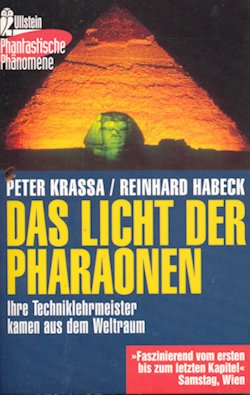
|
| Fig. 1 – The book in question |
On my old site I had no book reviews – with one exception. The book "Das Licht der Pharaonen" (Lights of the Pharaohs) by Peter Krassa and Rainer Habeck was so bad in many categories that I HAD to review it. In preparing this new site I planned to discard it, since the book is quite old and long out of print. But their work is even today a fixed element of Ancient-Asronaut(AA)-lore and it pops up almost on a daily base in discussions on message boards or facebook groups, so I decided to keep the review.
Not only that. Because the argumentations of the book often appear on English language boards, although the book never was translated into it, I decided to expand the review and translate it into English. Here you see the result.
There are good AA books and there are bad ones. Good AA books need not to be true, but they should give inspiration and food for the thought. Some of the best AA-books are still the early works of Erich von Däniken – although today I doubt that he was ever earnest (see Erich und die Pyramiden).
Bad AA-literature is unreadable like the books of Zecharia Sitchin, or they are copycat books like these of many German authors. The book of Krassa and Habeck is different. It is well written and the reader gets the feeling that the authors did good research. But I have never read a book in which the reader is so consequently and systematic lied to. Wild claims are not presented as thesis but as facts. Worse: the informed reader sees that the authors have sufficient background knowledge, but they turn and twist it around in a perverted way to prove their “truth”. And that is really bad. Here some representative examples:
They start right in the first chapter. Without any evidence they write
"It (the pyramid, FD) has a square base. Each of its four sides has a lengrh of 230 meters. Measured from the foundation to the top the pyramid of Pharaoh Khufu has a height of 137 meters. In its original configuration it was even 12 m higher – 149 meters.
The reduction of its size today has valid reasons: like so many sites of cultural historic value in Egypt and elswhere, the so-called “Great Pyramid” was, being the most elaborate monument of pharaonic greatness, during the centuries the target of predatory assaults. The pyramid vandals were longing primarily for the gold which was used on a large scale for the decoration of the building, in form of hieroglyphic signs that were scratched into the white granite tiles that covered the 2.3 million stone blocks from the bottom to the apex of the pyramid. This gold was avidly scratched out and misused this way.
Of special interest was at that time the godly symbol with a special significance that originally crowned the top of Khufu's pyramid: a golden globe!
It had a diameter of several meters and was used by the priests as a lightning rod. These constructions also protected other temples.
Sadly this golden emblem fell victim to the ravenousness of the pyramid vandals. To get hold of the gold dust of the pyramid inscriptions the thiefs knocked little by little all granite tiles to rubble. They left only the naked cult site ..."[1]
There are incredibly many factual mistakes in these few lines, but the authors present them – without giving a source - as irrevocable facts.
The lightning rod at the top of he pyramid is used, as can be seen clearly, by the authors as introduction to their “the Egyptians had knowledge about electricity”-thesis. But nothing is known about such an adornment on any temple or pyramid in Egypt. Also, the found and exhibited pyramidions (capstones of pyramids) show that there was never such a device mounted. The whole lightning rod thesis is a wholeheartedly lie.
By the way: Krassa and Habeck tend to see everything in Egypt as lightning rods, pyramidions and even Flag poles!
Oh, and a sphere as lightning rod? Every student of physics or electric engineering in the first semester knows that a lightning is best attracted by a peak. A grounded, copper clad pyramidion would work much better than a “sphere with a diameter of several meters”.
Also, nothing is known about golden inscriptions on pyramids. There is one arabic account mentioning blue inscriptions on a pyramid – blue gold? I don't think so.
The remaining part of this chapter is also far from reality. The pyramid vandals have destroyed the granite tiles of Khufu's pyramid? What tiles? The pyramids were not clad with tiles like roof tiles, but with massive diagonally cut, a meter wide stone blocks with weights of up to several tons, in the lower layers heavier than the building blocks used there. The authors should demonstrate how to “knock” such things to pieces. Oh, and the pyramid of Khufu was completely covered with casing blocks of hard Tura limestone, and not with granite blocks.
In these few lines from chapter one are the following mistakes:
Although these mistakes have no consequence for the electro-thesis, such an accumulation at the very beginning sheds a bad light on the remainder of the book.
I already mentioned lightning rods. Krassa and Habeck think that almost every upright structure in Egypt was such a device. I thought that it was their own, funny idea – and then I stumbled in an antique book shop in Frankfurt over a book in which I could read this:
"At some times it was fashion to consider that Egypt was the source for all wisdom. ... To this day nothing of this praised wisdom has been unearthed. The procedures used by those assuming at the slightest indication that the Egyptians possessed astonishing knowledge does in most cases not hold up to unbiased examination. One example of many: Somewhere on the roof of the temple of Dendera is an inscription telling us, masts of the pylons, capped with copper tips, were erected to "scratch the thunderstorms out of the sky". Therefore we are told that these masts were "without doubt the oldest lightning rods in the world" (eg. at Oppel, Das alte Wunderland der Pyramiden, p. 354). With astonishment we read that a culture where thunderstorms are one of the greatest rarities … had thousands of years before Christ a knowledge that gave its modern discoverer Benjamin Franklin such tremendous fame. At closer examination the whole conclusion becomes invalid. A lightning rod needs a tip, an insulated wire and a grounding. To invent such a device a respectable knowledge about electricity is necessary.
… [The author continues explaining why the Egyptians knew nothing about ground cables , not even of metal cables at all, and that no sign of the use of electricity was ever found to conclude this chapter with]
These poles have nothing in common with a lightning rod."[2]
Astonishing: this is from a book published in 1896! The lightning rod idea was discussed and disproved by science almost a hundred years before Krassa & Habeck published their book! But still these claims are published by AA authors as "new discoveries".
To be mysterious enough the temple of Hathor must be old, because a temple from, say, 50 B.C. Containing such reliefs for the first time clearly has no influence on old pharaonic Egypt.
So krassa and Habeck are “making” the temple old by using some tricks. First they declare the Dendera zodiac to be “prehistoric”. This zodiac is a kind of miniature planetarium in the ceiling of a small chapel on the roof of the temple of Hathor. If the zodiac is prehistoric, the temple underneath it mus be even older. And the zodiac, showing constellations and planetary positions, is prehistoric because "the shown constellations do not coincide with those visible in our time".
This is, like so much in their book (that claims to be the hippest and most innovative and world—changing thing on plaet Earth), completely outdated. At the end of the 19th century, more than a hundred years ago, astronomers tried to date the age of the zodiac by analysing the constellations. It was suggested then, that it shows a real image of the sky at a specific time. Without success.
After long and thorough analyses it was clear that the zodiac displayed an impossible constellation of the sky, because for example Venus and Mercury stand in an impossible angel to each other. It is therefore not a concrete image of the sky at a given time but only a schematic image of all constellations and planets known[3] This is known since the 1920es , for almost 70 years before they published their book. The authors try to change world history by using evidence disproved for 70 years - silly.
Also, it is proven that the zodiac dates to the late Greek period in Egypt and is not prehistoric. It shows not only the signs the Egyptians referred to (they had no real star signs, only asterisms), but also the Greek signs of the zodiac. It can therefore be not older than from 332 B.C. When the Macedonians under Alexander the Great conquered Egypt.
Further, Krassa and Habeck are re-dating the crypts. In the chapter “Wonders of stone” we can read under the head line “The discoveries of Napoleon”:
"It was reserved to French archaeologist Auguste Mariette to discover in the middle of the 19th century in the underground catacombs of Dendera (a temple designated to the goddess Hathor 60 km north of the tourist hub Luxor) so far completely unknown relief. They also contained a hieroglyphic language that has very few in common with the inscriptions on the rosetta stone. Hieroglyphs of an older epoch of Egypt that could not accurately be dated yet. The decipherment has now begun."[4]
This is nothing more but a big fat lie. It is true that the early Evgyptologists in the 19th century had problems with the translation of these texts – but for complete different reasons. The inscriptions were too young. Even then it was clear for the Egyptologists that the trmple was from the so-called greco-roman time that began in Egypt in 332 B.C. ...
Egyptian writing is based predominantly on syllables. One hieroglyphic sign represents normally up to three consonants forming, together with not written vocals, spoken syllables. This old writing system needed relatively few signs. But from the beginning on there were signs used only as ideograms (the sign really showed the object it stands for) and as determinatives (signs that were used to show in which context the word it was in was used). All together about 750 signs in the early times of Egypt. All these signs are well known and their loud value or meaning is undisputed.
Much later, about 2000 years after the end of the pyramid age, Egypt was conquered and ruled several times ny its neighbours. And all liked hieroglyphics and they began to add their on signs. At the the time Egypt became a Roman province about 8000 signs were used, many of them were used only in a few inscriptions. It was therefore very hard to guess their meaning. Also, the new rulers introduced a new grammar that differed from the then-known middle Egyptian. Without knowledge of these new rules it was difficult to make sense of these writings. The famous German Egyptologist Hermann Junker used several years to make sense of the grammar – and published his book „Die Grammatik der Dendera-Texte“ (Grammar of the Dendera texts) in 1909! About 80 years before the work by Krassa & Habeck.
Long before their book partial translations of these texts were published, eg. by Daumas in 1969[5] – almost 20 years earlier “The decipherment has now begun” - what a joke.
And before I forget: there are no runes on the rosetta stone, and the Dendera writings are younger than the rosetta stone. The only thing Krassa and Habeck got right: Waitkus was the first person publishing a complete translation of the inscriptions of these crypts. A complete edition of the texts in all crypts was published in 2001.
By the way: Waitkus has no doubt about the age of the temple and the inscriptions. Already in the introduction he writes “Generally, the King (Ptolemäius XII) goes to a group of deities in the scenes of the side walls of the crypts...“[6]. Ptolemäius XII lived, that was best known at that time, around 50 B.C.
Some readers suggested that the reliefs were occupied by Ptolemeius XII and is in reality much, much older. But that is not possible with this kind of raised relief. In this relief type everything NOT belonging to the planned elements is removed. It is not possible to put plaster on it and chisel in a new name. Texts and reliefs are without doubt from the ptolemeic era. This is also visible on the proportions humans are shown, these proportions were only used after the conquest of Egypt by Alexander around 332 BC. Prehistoric is something different.
Something goes wrong with these two world changers ...
Quite at the beginning of the book our two authors ponder abut the crypt of the temple:
„A temple, dedicated to the goddess Hathor, with equal. Massively built only two fifth rise up from the desert soil. The largest part is subterran, separated into three stories it has all together twelve crypts...“[7]
This happens when only the “looks like”-method[8], which is very popular with AA authors, is used and explaining texts are ignored. Sure, in the publications of Mariette and Waitkus are cross section plans that look like gigantic rooms under the whole temple. But Waitkus explains in his book:
“The decorated crypts of the temple of Dendera are located IN THE OUTER WALLS and the foundations below them in the back section of the temple (Naos).“[9]
On this ground plan in the book of Waitkus the crypts are clearly visible: they are the narrow channels in the walls, small and claustrophobic, to pass each other you have to press your backs against the walls. If only they had read their sources and not only looked at the images...
By the way: the authors claim to have been for several hours in the crypts. They should have noticed how small these chambers are.
I will not conceal another looks-like gem to you. In the crypts they discovered this relief, it's in the room immediately before the “lamps”:
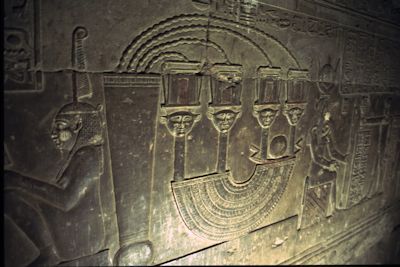
What can this be? Clearly something Ancient Astronatish, what else? They write:
„We see two small platforms on a richly ornamented semicircle. On one of these is a small bowl with an oval object. Four thin columns crowned each with a head of Hathor rise vertically from the semicircle. They are connected via an intertwined cable-like string leading to a vase-like object. At the bottom we see the cross section of a fruit that looks to the spectator like an orange or a lemon.
...
We are sure to have identified … a galvanic device – an electricity generating appliance that possibly worked like the parthean batteries in Baghdad.“[10]
Then thy muse about electrolysis and about the “object” in the “bowel” that is in their opinion electroplated with gold – oh, and, of course about the “fact” that scientists are all blind to the obvious:
„Egyptologists only see – an amulet, an interpretation we do not follow after our thorough analysis.
...
We showed two reputable Egyptologists photos of the so-called amulet. … We don't know if they knew each other – solidarity between Egyptologists united them in their statement. They insisted on recognising in the relief a so-called Menet-symbol.“[11]
Yes, stupid, blind Egyptologists, insisting on their expert knowledge.
Anyone knowing a bit about Egyptian jewellery sees instantly that the object is a so-called pectoral This is a heavy breast ornament made of gold and precious stones. It is a common object in Egyptian art, look at that falcon from Abydos for comparison:
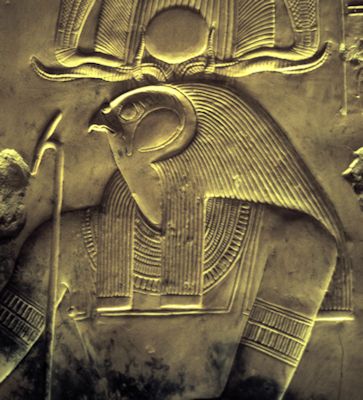
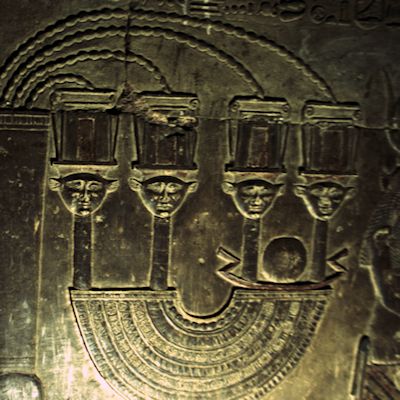
The adorned semicircle around the neck of Horus is clearly recognisable. The decoration is similar to that on the Dendera relief.
These pectorals were heavy, often weighing several kilograms. That was too heavy to carry for the neck. What Krassa and Habeck interpret as “platforms” are in fact the massive end pieces of the pectoral, where it was hung up. Four strip of usually leather (the “columns”) carried the breast piece, leading over the shoulders and connected with clips (Hathor-heads) and chains to a counter-weight hanging down from the back. This way, the shoulders carried the weight, and not the neck.
Funny: the experts they asked seemed to have explained them exactly that, because in the following passages the authors are making jokes about stupid “counterweights” making it even heavier. Thes clearly have not understood the explanation.
Before I forget: the “bowl” with the galvanised object is the stylised solar barge with the sun.
There is not only the picture of the pectoral, thee are also texts surrounding it. What do they say?
“Come in peace, ruler of mntj. … I received your wonderful thing (sc Pektoral) which is done well with precious stones.
...
Bringing the pectoral of gold,
Words to speak: „This is the protection of your majesty for the festival, made of ktmt-gold.“
...
I have knotted this amulet from gold.“[12]
I can see nothing in these texts that suggests any other thing than an amulet. The crypts were used to store precious cult objects, so we can presume that the shown amulet was stored in this room.
I will finish this detour through the land of “looks like” with a real looks-like-classic. In the table section they show two photographs side by side, one of a launching rocket, the other one with an obelisk. In the comments of the pictures they write::
„5 – Obelisks have conquered as ancient Egyptian symbol the whole world. But at the beginning they had a different meaning. They represented factual images of pre-Egyptian missiles which were formed like rockets.
6 – The similarity between an obelisk and a modern rocket is no accident. In its archetype he brought, according to traditions, the “sun god” to Earth. This god hiding behind this was nothing less than Thot.“[13]
Ouch, that hurts. As “modern rocket” they show the pencil-thin “Vanguard” which was used in the 1950s by the USA trying to launch a satellite. It was an almost complete failure, with the exception of the tiny, about 10 cm small “Vanguard I” (scoffed by Chruschtschow as “space-grapefruit”) it was a lemon. Modern rockets are not so extremely pencil thin...
Also bad: the shown form of obelisk is a very late invention. The first ones were not even man high stone pillars in the temple courts of pyramids in late Dyn. VI, around 2300 BC. They developed into the needle sharp form only 1000 years later during the New Kingdom. And the basic forms of obelisks were the sun-sanctuaries of the fitth Egyptian dynasty. These loked like strange crooked squat pyramids and have no resemblance to rockets at alls And even this archetype was not pre-Egyptian, it appeared around 700 years after the foundation of the unified Egypt by King Menes.
Clearly visible is the total lack of knowledge about the culture our two world-changers want to rewrite...
Oh, before I forget: The sun god is still Re, whereas Thot is the god of the MOON!
On the cover of the book it reads “Their technical teachers came from outer space”. So these aliens from outer space have been involved in everything and have even assembled the primitive clay pot batteries. Obviously they did not have any clue about the electrochemical series – because otherwise they would have chosen a better metal combination.
To heat up the readers they come up in the following chapters with wild speculations about nuclear reactors and the Ark of the Covenant and radiation protection made of cotton and so on.
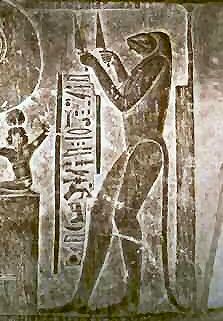
|
| Fig. 6 – Thot? |
Additionally they present the reader (much to my surprise) a brand new arrangement of Gods. For example they claim that Osiris was the child of Nut and Thot. And in this case Nut was not the Goddess of Heaven but an allegory for Heaven and Thot was – of course – an astronaut. [14]
Ok, well, in the Myth of Osiris he had been fathered by the God of Earth, Geb, and Thot was only a scribe and vizier of Osiris. But what doesn’t one do for having an astronaut in the picture.
But why do they keep harping on poor Thot? Because this (wrong) presentation of this God is only the introduction of more chapters which revolve around misinterpretations of the stupid Egyptologists. Well, seen through their eyes, Thot was a scientist and the man behind all these Dendera pictures. At least he is, so they say, the central person on these reliefs, the one with the knife in his hand. Really?
This is strange, because Thot is not even mentioned with one word on all the texts which belong to all these pictures!
We find these lines instead:
„Upu:
Your name is perfect as Upu. Your face is that of a toad.
„I have killed your enemies with knifes, and I fell your opponents at the place of execution.“[15]
As I have already mentioned before, Upu is the mate of Hathor and protector deity of the Somtus this reliefs are about So unfortunately they do not have anything to do with Thot.
And this is the reason why you can just throw away 2/3 of this book…
This Thot came from somewhere and Krassa/Habeck considered him to be a real person. And where is it written, where he came from? Of course, in the Book of the Dead, which they assume to be a travel report of astronauts from outer space.
I must confess that I bursted out laughing when I read this chapter (“Ein Gott steigt vom Himmel” - A God descended from Heaven). This MUST be a satire – or do they really believe this?
They start with a passage from chapter 17 of The Book of the Dead:
“Yesterday I saw the birth of Re,
who appeared from the depth of the sky
find out, his power is in truth my power
because a mighty being I am
A god between the gods that surround Horus.“[16]
Subsequently they fabulate about mighty spaceships and “putting it straight” that Re is not a Sun God but only the name of the mighty spaceship of Thot, which they have already redefined before as a Son God. Because:
“Thot was the commander of the expedition. He sat in the cockpit of the ship Re, FD), steering the aerial vehicle and could be called for this reason 'heart' of the space ship crew.“[17]
If there weren’t some tiny problems. The Book of the Ded is not a book at all, but a collection of proverbs which have been painted on papyrus and laid into the graves of the deceased or chiseled onto walls or coffins in the tombs. There are short ones and longer ones and in later times the trade with this kind of blessings must have been a good secondary business for the priests. The blessings do not derive from a certain period but have been written down and changed again during thousands of years. First as pyramid texts of the Old Kingdom and afterwards as coffin Texts and in the New Kingdom as Book of the Dead. Todays used term “Book of the Dead” is misleading. These proverbs are not in a chronological order and do not tell a tale but are a collection of good advise instead. How to behave towards Horus. How to protect oneself from the danger of the underworld. How to behave on the Tribunal of the Souls and so on. Krassa/Habeck evaluate the blessings as if they would tell a continuous story and not as if it was only a collection of blessing – for them it is like a (narrative) epos! And this is weird and can hardly be exceeded.
But what about the particular spell which announces the spacecraft? Well, it is only a very small part of the history of creation in which God Atum, creator of the world, tells how he made the world and the Gods. In verse 18 (of 33) Atum says:
“I have seen this Re
who was born yesterday on the hind leg of the heavenly cow
If he is well, so am I well and if I am well so he is well.“[18]
The following sentence, which they cite does not refer to Re.
Translator Erik Hornung kindly writes the following remark: “This is the scene of the eye of Re that is reborn on the early morning every day.“[19]
A landing spaceship from outer space becomes the simple daily sunrise. Context can be really … difficult. No wonder that many authors rather ignore it.
Unfortunately Krassa/Habeck do not mention where they got their significantly deviating “translation” from...
Afterwards they mix up several other myths like the Edfu-Texts. These originated in greek time (the temple has been completed 57 BC, 3 years before the construction of Dendera began, which is appropriate) but that doesn’t matter to them – for these authors is everything which is suitable for their ideas “ancient”.
ABut that is not enough for them. They use more tricks to prove the cosmic origin of the creator of the lamp. The Egyptians never ever had a “scientific” astronomical view of the world. They considered the sky as a plain which was spanned over their heads like a big tent. On this surface of the sky several things took place. The sun barque sailed over the surface of the water, the stars were souls, which were glued to the belly of Nut, the Goddess of Heaven, and so on. A very simple, religious orientated and proven many thousand times.
The good wishes of the Bookk of the Dead which is based on this 2D-Universe have been transformed by Krassa/Habeck into our current 3D-Universe without hesitation. And suddenly the wish from a concerned relative, that the deceased may reach the ferryman to paradise becomes a report about a flight to the moon. Wishes that the deceased may encounter certain Gods (which are substituted by Krassa/Habeck by our modern planets) on his journey to the stairway to Heaven are even being transformed into reports about interstellar space patrols.[20]
However, K/H’s efforts to bring every part of the mythology on the level of space ships are really odd here and there, for example when they try to identify this:
"Look, a God is born.
The lashing of the heavenly barque is complete. Now he seizes the oars…"
as a radio message from the cockpit of a space ship.
In the whole segment (A God descended from Heaven and the following) Krasse/Habeck work with the old texts which they seem to be familiar with. But they extremely twist and misinterpret their contents and backgrounds. Because, of course, these two amateur researchers know better how to interpret these texts than those who deal with the texts for decades. About the translator of the Dendera-inscriptions, Egyptologist Wolfgang Waitkus, they only have a mocking comment left:
“As a part of his dissertation he succeeded in translating the messages of the ancient reliefs. Of course his interpretation deviates significantly from ours, but that does not matter."
No Comment.
I could bitch about this book a lot more and fill several pages with it, but I guess that the points I have already mentioned are sufficient to make clear which methods have been used by Krassa/Habeck. Another point would be, for example, their forgetfulness: On the one hand they relate the pyramids to the Egyptians when they shpold be lightning rods, but a few pages later they "forget" this, only to mediate about the secret of their origin. They exploit the history about the Ark of the Covenant and its assumed purpose as an energy store, a capacitor. And they tell us that nobody has ever been able do build a functional Model of the ark-capacitor, only to claim a few seconds later that a successfully working replica has been introduced several times. Et cetera … But there is an even “krassa” thing they want to make us believe: The Egyptians should have been too stupid to invent their own national drink – beer. Even how to brew the beer was taught them by the Gods – “astronaut’s brew”? Were the fights in the ancient epos “Mahabharata” maybe "galactic beer wars (tm)" of hostile brewery empires?
As I have already written before: I consider this book to hit rock bottom of Ancient Astronaut literature and I hope I have explained clearly enough WHY.
| Remarks/Sources: | |
| [1] | Krassa, Peter & Habeck, Reinhard; Das Licht der Pharaonen p. 16 f |
| [2] | Stern, Bolko; Ägyptische Literaturgeschichte 1896 p. 106 ff |
| [3] | eg.. Comnan, Johanne; Ancient Egyptian Sky Lore 2013 |
| [4] | Krassa/Habeck p. 30 |
| [5] | Daumas, François; Dendera et le temple d'Hathor Kairo/Paris 1969 |
| [6] | Waitkus p. 9 |
| [7] | Krassa/Habeck p. 10 f |
| [8] | The method is easy. Only look at the pictures, ignore the context of the culture and what the creators wrote about it, and view everything through personal “I see this”-tainted glasses. This way chrurch towers turn into rockets, underworld symbols to space capsules and overlayed inscriptions to helicopters... |
| [9] | Waitkus p. 7, emphasize by author |
| [10] | Krassa/Habeck p. 41 f |
| [11] | ibid. |
| [12] | Waitkus, p. 128ff |
| [13] | Krassa/Habeck plates 5 & 6 |
| [14] | Krassa/Habeck p. 102 ff |
| [15] | Waitkus, p. 128 |
| [16] | Krassa/Habeck p. 118 |
| [17] | Krassa/Habeck p. 125 |
| [18] | Book of the Dead §126-128, translation from Hornung, Erich; Das Totenbuch der Ägypter Goldmann 1993, p. 65 |
| [19] | ibid. |
| [20] | All this in chapter VIII „Die geflügelte Sonnenscheibe“ (the winged solar disc), p. 147 ff |